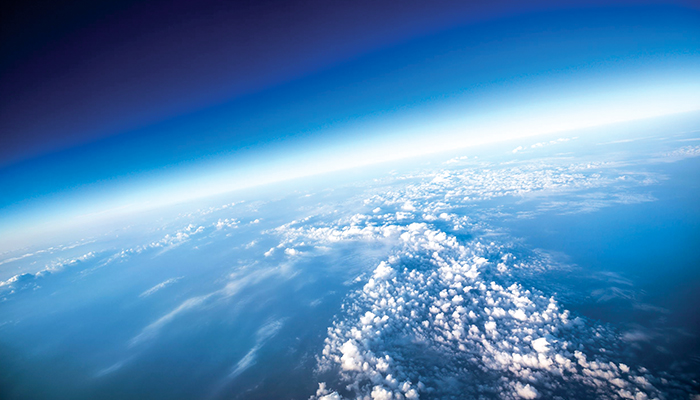All
The Hole in the Ozone Is Getting Smaller
by Ed Burke, Dennis K. Burke Inc.

You remember the hole in the ozone, right? Well, scientists at MIT say they have identified the “first fingerprints of healing” of the ozone layer over the Antarctic.
In a paper published in the journal Science, researchers say the hole is definitely getting smaller. In fact, the team found that the ozone hole has shrunk by more than 4 million square kilometers (about half the size of the U.S.) since 2000, when ozone depletion was at its peak. The researchers were also able to show that volcanic eruptions slowed down the recovery of the ozone layer at times. The authors attribute the ozone’s recovery to the continuing decline of atmospheric chlorine originating from chlorofluorocarbons (CFCs).
A Little History
In 1913, a pair of French scientists used an interferometer to make the most accurate measurements ever of ozone in the atmosphere. They discovered that ozone collects in a layer in the stratosphere, roughly 12 to 18 miles above the surface, and absorbs ultraviolet light.
In 1974, a groundbreaking paper showed that CFCs used as a propellant in spray cans destroy atmospheric ozone, earning the authors a Nobel Prize.
In 1985, atmospheric scientists from the British Antarctic survey thought their instruments were broken when they began to show drastic drops in ozone over the Antarctic. The equipment was working properly—they had found a hole in the ozone.
Banning CFCs
When news of the ozone hole hit the media, it was a real eye-opener. If the ozone hole grew, it would allow more damaging ultraviolet rays to hit Earth, with devastating impacts. We were actually losing the ozone that provides essential protection from the sun’s scorching rays. There were a lot of concerns that there would be spikes in skin cancer and cataracts, as well as other health issues. That radiation would also devastate wildlife, fisheries and agriculture. It was a man-made environmental catastrophe that grabbed the world’s attention.
Unfortunately, CFCs were used in all sorts of products, from air conditioning to aerosol cans. The CFCs used in dry cleaning, refrigerants, solvents and propellants were being released into the atmosphere. To save the ozone, chemical companies would need to phase out ozone-destroying products and switch to alternatives.
In 1987, countries all around the world agreed to adopt the Montreal Protocol in a global effort to ban the production of CFCs, R22, halons and other ozone-depleting chemicals.
Some 30 years later, the hole in the ozone layer is “on a path to heal,” says lead author Susan Solomon, Professor of Atmospheric Chemistry and Climate Science at MIT. “We did something collectively, as a world, and now we’re seeing the planet respond.”
September Not October
Ozone is sensitive to chlorine, temperature and sunlight. Chlorine eats away at ozone, but only if light is present, and if the atmosphere is cold enough to create polar stratospheric clouds where chlorine chemistry happens. Solomon was first to characterize this relationship back in 1986.
The data shows that ozone depletion starts each year in late August, as Antarctica emerges from its dark winter, and the hole is fully formed by early October. Solomon and her colleagues believed they would get a clearer picture of chlorine’s effects by looking earlier in the year, at ozone levels in September, when cold winter temperatures still prevail and the ozone hole is opening up. The team showed that as the chlorine has decreased, the rate at which the hole opens up in September has slowed down.
“People, including myself, were too focused on October, because that’s when the ozone hole is enormous, in its full glory,” Solomon says. “September is a better time to look because chlorine chemistry is firmly in control of the rate at which the hole forms at that time of year.”
So from 2000 to 2015, the researchers tracked the yearly opening of the Antarctic ozone hole in the month of September. They analyzed ozone measurements and sulfur dioxide emitted by volcanoes, as well as tracking temperature and wind. They then compared their yearly September ozone measurements with model simulations that predict ozone levels based on the amount of chlorine that scientists have estimated to be present in the atmosphere from year to year. They further found that this decline matched the model’s predictions, and that more than half the shrinkage was due solely to the reduction in atmospheric chlorine.
The team also noted an important observation outside the healing trend. In 2015, the ozone hole reached a record size, despite the fact that atmospheric chlorine continued to drop. Going through the data, however, Solomon and her colleagues realized that the 2015 spike in ozone depletion was due primarily to the eruption of the Chilean volcano Calbuco. Volcanoes don’t release significant chlorine into the stratosphere, but they do increase small particles that increase the amount of polar stratospheric clouds that react with the man-made chlorine.
So, the ozone hole is finally on the mend. The September ozone hole has shrunk to 17 million square kilometers, and if all goes well, the hole should be healed by 2050 or so.
Related Posts
 Why Quality Matters in Your Biofuel Blends
Why Quality Matters in Your Biofuel Blends
Posted on June 25, 2025
 HEAT Show Gears Up
HEAT Show Gears Up
Posted on June 25, 2025
 What’s Next in Boiler Technology
What’s Next in Boiler Technology
Posted on June 25, 2025
 How Intelligent Are Your Integrated Customer Platforms?
How Intelligent Are Your Integrated Customer Platforms?
Posted on June 25, 2025
Enter your email to receive important news and article updates.
